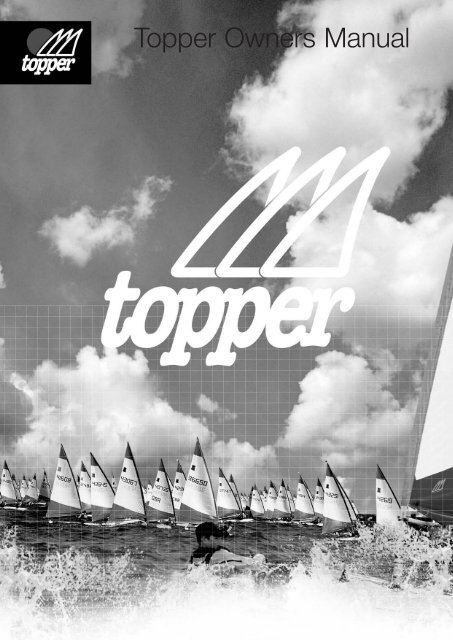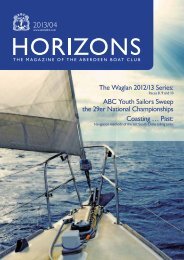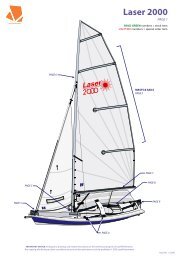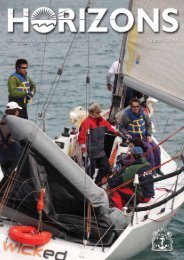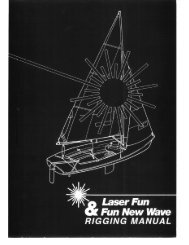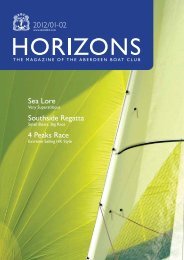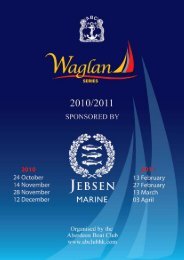Owners manual Topper - the Aberdeen Boat Club
Owners manual Topper - the Aberdeen Boat Club
Owners manual Topper - the Aberdeen Boat Club
You also want an ePaper? Increase the reach of your titles
YUMPU automatically turns print PDFs into web optimized ePapers that Google loves.
<strong>Owners</strong> <strong>manual</strong> <strong>Topper</strong> 8/2/06 12:34 Page 4P4. ContentsYour <strong>Topper</strong>p5. The Control Lines - Identificationp6-7. Sail Numbers - How to apply <strong>the</strong>mp8. Preparing <strong>the</strong> mastSleeving <strong>the</strong> sailp9. Stepping <strong>the</strong> mastFitting <strong>the</strong> boomp10. Mainsheet & Rope HorseDownhaul and Kicking Strapp11. Rudder and DaggerboardReefing <strong>the</strong> sailp12. The <strong>Topper</strong> Race Packp16. Adjusting <strong>the</strong> Sailp17. Tuning for Performancep18. Car Toppingp19. Care and maintenancep20. GuaranteeJoin <strong>the</strong> <strong>Club</strong>! - ITCAp21. ITCA membershipRegister of GuaranteeI.B.C. Declaration of Conformityback cover <strong>Topper</strong> International contact detailsWelcome to <strong>the</strong><strong>Topper</strong> ClassCongratulations on becoming <strong>the</strong> owner of a brand new<strong>Topper</strong> sailboat. We at <strong>Topper</strong> International believe that<strong>Topper</strong>’s advanced design and sophisticated constructionprocess will ensure that you enjoy many years of troublefreeand exciting sailing.To enhance <strong>the</strong> enjoyment of your new <strong>Topper</strong> wehave arranged for new <strong>Topper</strong> owners to receive FREEmembership of <strong>the</strong> <strong>Topper</strong> International Class Associationfor <strong>the</strong> first year of ownership.There are many benefits and full details are included in thisOwner’s Manual.If you should incur any problems with your <strong>Topper</strong>, our salesstaff will be pleased to offer advice and supply any spareparts and accessories you may need. Your International<strong>Topper</strong> Class Secretary will be pleased to advise you on <strong>the</strong>many aspects of <strong>Topper</strong> ownership.
<strong>Owners</strong> <strong>manual</strong> <strong>Topper</strong> 8/2/06 12:34 Page 5P5. Control linesA Centre Mainsheet and an Aft Rigged Mainsheet areavailable. The Aft Rigged Mainsheet kit is pictured below.The Centre Mainsheet kit is pictured on page 12.Before attempting to assemble your <strong>Topper</strong>, carefully study<strong>the</strong> diagram on <strong>the</strong> inside front cover of this handbook andthoroughly familiarise yourself with all <strong>the</strong> components, <strong>the</strong>ircorrect names and places on <strong>the</strong> boat.If you follow <strong>the</strong>se rigging instructions, stage-by-stage youwill find <strong>Topper</strong> incredibly simple and quick to prepare for<strong>the</strong> water. When you have unpacked everything, lay out <strong>the</strong>various control lines on <strong>the</strong> foredeck and identify <strong>the</strong>m:A. Main Halyard LoopB. Kicking StrapC. DownhaulD. MainsheetE. Bow PainterF. OuthaulG. TravellerH. Daggerboard ShockcordI. Toe Strap ShockcordDHAIBGEFCOn <strong>the</strong> following pages we have continued this codingsystem on <strong>the</strong> photographs so that you can immediatelyidentify each control line.
<strong>Owners</strong> <strong>manual</strong> <strong>Topper</strong> 8/2/06 12:34 Page 6P6. Standard <strong>Topper</strong>Sail numbers andNational letteringSAIL NUMBERS (please note all measurements areminimums)- Should be placed on both sides of <strong>the</strong> sail with <strong>the</strong>numbers on <strong>the</strong> starboard side being above <strong>the</strong> ones on <strong>the</strong>port side.- They should be placed two panels below <strong>the</strong> TopHat logo.- The height of <strong>the</strong> numbers should be 230mm.- The numbers are supplied as ‘digital eights’ from whichyou can produce your own sail number.- The preferred style of cutting numbers from ‘digital eights’is shown below.- There should be 45mm between each element of <strong>the</strong>complete number.- The numbers should be in a contrasting colour to <strong>the</strong>white sailcloth.STARBOARD SIDE- The upper edge of <strong>the</strong> letters should be placed 45mmfrom <strong>the</strong> upper seam of that panel.- They should start 45mm from <strong>the</strong> back of <strong>the</strong> sail.PORT SIDE- The upper edge of <strong>the</strong> port letters should be 45mm below<strong>the</strong> ones on <strong>the</strong> starboard side.- They should finish 45mm from <strong>the</strong> back of <strong>the</strong> sail.ATTACHING NUMBERS & LETTERSIn our experience <strong>the</strong> best way to stick<strong>the</strong> numbers down is to peel away acorner, line up <strong>the</strong> letter and <strong>the</strong>nattach <strong>the</strong> corner. Pull away <strong>the</strong>backing paper slowly as you push<strong>the</strong> number onto <strong>the</strong> sail. Fiddlybut it works!If in doubt -please askSTARBOARD SIDE- The upper edge of <strong>the</strong> numbers should be placed 45mmfrom <strong>the</strong> upper seam of that panel.- They should start 45mm from <strong>the</strong> back of <strong>the</strong> sail.PORT SIDE- The upper edge of <strong>the</strong> port numbers should be 45mmbelow <strong>the</strong> starboard side numbers.- They should finish 45mm from <strong>the</strong> back of <strong>the</strong> sail.GBR LETTERS- Should be placed on both sides of <strong>the</strong> sail with <strong>the</strong> letterson <strong>the</strong> starboard side being above <strong>the</strong> ones on <strong>the</strong> portside.- They should be placed in <strong>the</strong> panel beneath <strong>the</strong> Top Hatlogo.- The height of <strong>the</strong> letters should be 230mm.- They should be pre-formed letters at least as clear ashelvetica.- There should be 45mm between each element of <strong>the</strong>complete letter.- The letters should be <strong>the</strong> same colour as <strong>the</strong> sail numbers.* NOTE: TOPPER Sail Numbers are derived from digital 8 numbers. Ten digital 8 numbers are supplied, from which anynumber from 0-9 can be obtained. Above you will find a simple chart showing how to obtain <strong>the</strong> number you require.
<strong>Owners</strong> <strong>manual</strong> <strong>Topper</strong> 8/2/06 12:34 Page 7P7. ChampionshipSail numbersIf in doubt -please askBefore you sail your new boat for <strong>the</strong> first time, it is mostimportant to apply <strong>the</strong> self-adhesive numbers to <strong>the</strong> sail.The sail numbers are exclusive to <strong>the</strong> boat and correspondwith <strong>the</strong> serial number/sail number plate. These are alwayslocated inside <strong>the</strong> boat attached to <strong>the</strong> toe strap.Follow <strong>the</strong>se instructions carefully it is not a job to behurried.CHAMPIONSHIP NUMBERS(please note all measurements are minimums)- Should be placed on both sides of <strong>the</strong> sail with <strong>the</strong>numbers on <strong>the</strong> starboard side being above <strong>the</strong> ones on <strong>the</strong>port side.- The height of <strong>the</strong> numbers should be 230mm.- The numbers are supplied as ‘digital eights’ from whichyou can produce your own sail number.- The preferred style of cutting numbers from ‘digital eights’is shown below.- The outside corners should be snipped as shown above.- There should be 45mm between each element of <strong>the</strong>complete number.- Both sets of numbers should be in <strong>the</strong> 2nd coloured panelfrom <strong>the</strong>bottom of <strong>the</strong> sail.- The numbers should be in a contrasting colour to <strong>the</strong>sailcloth.- Use white numbers on red/ dark blue/purple sail panels.- Use black numbers on grey/ light blue/ yellow/ orange sailpanels.Snip 2/3mm off <strong>the</strong> corner ofall championship numbersPanelRedDark BlueLight BlueGreyYellowPurpleOrangeNumberWhiteWhiteBlackBlackBlackWhiteBlackSTARBOARD SIDE- The start of <strong>the</strong> number should be placed 45mm from <strong>the</strong>leech of <strong>the</strong> sail.- The upper edge of <strong>the</strong> number should be 45mm from <strong>the</strong>upper seam of <strong>the</strong> panel.PORT SIDE- On <strong>the</strong> port side of <strong>the</strong> sail, <strong>the</strong> upper edge of <strong>the</strong>numbers should be 45mm from <strong>the</strong> lower edge of <strong>the</strong>starboard numbers.- The end of <strong>the</strong> last number should finish 20mm from <strong>the</strong>reinforcement patch.ATTACHING NUMBERSIn our experience <strong>the</strong> best way to stick <strong>the</strong> numbers downis to peel away a corner, line up <strong>the</strong> letter and <strong>the</strong>n attach<strong>the</strong> corner. Pull away <strong>the</strong> backing paper slowly as you push<strong>the</strong> number onto <strong>the</strong> sail. Fiddly but it works!
<strong>Owners</strong> <strong>manual</strong> <strong>Topper</strong> 8/2/06 12:34 Page 8P8. Preparing <strong>the</strong>mastPreparing <strong>the</strong> mast1.1. Slot <strong>the</strong> two mast sections toge<strong>the</strong>r, making sure that <strong>the</strong>slots in <strong>the</strong> upper section have properly engaged with <strong>the</strong>rivets in <strong>the</strong> lower section.sleeving <strong>the</strong> sail1. Unfold <strong>the</strong> sail and lay it on <strong>the</strong> ground with <strong>the</strong> bottomedge of <strong>the</strong> luff sleeve adjacent to <strong>the</strong> top of <strong>the</strong> mast.2. Insert <strong>the</strong> mast into <strong>the</strong> luff sleeve and pull <strong>the</strong> sail down<strong>the</strong> mast. If it is windy, keep your back to <strong>the</strong> wind!3. Continue until <strong>the</strong> whole sail is sleeved and <strong>the</strong> mas<strong>the</strong>adhas appeared through <strong>the</strong> top of <strong>the</strong> sail.Sleeving <strong>the</strong> sail2.4. Use <strong>the</strong> Halyard Loop to attach <strong>the</strong> sail to <strong>the</strong> top of <strong>the</strong>mast as shown.5. Tuck any surplus rope neatly inside <strong>the</strong> luff sleeve andinsert <strong>the</strong> burgee into <strong>the</strong> special socket.2-3.4.AA
<strong>Owners</strong> <strong>manual</strong> <strong>Topper</strong> 8/2/06 12:34 Page 9Stepping <strong>the</strong> mastStepping <strong>the</strong> mast1-21. Point <strong>the</strong> <strong>Topper</strong> into <strong>the</strong> wind, support <strong>the</strong> mast at a 45degree angle and engage <strong>the</strong> base of <strong>the</strong> mast into <strong>the</strong> cupunder <strong>the</strong> mastgate.2. Walk <strong>the</strong> mast forward into an upright position, ensuringthat <strong>the</strong> collar is underneath <strong>the</strong> mastgate.3. Pull <strong>the</strong> cord to close <strong>the</strong> gate.3.4.4. Push <strong>the</strong> toggle in firmly to lock.Fitting <strong>the</strong> boom1. Engage <strong>the</strong> gooseneck end of <strong>the</strong> boom on to <strong>the</strong> mastimmediately above <strong>the</strong> collar.Fitting <strong>the</strong> boom 1.2. Thread <strong>the</strong> outhaul (F) through <strong>the</strong> boom end fitting asshown, knotting <strong>the</strong> end securely.3. Thread <strong>the</strong> inboard end of <strong>the</strong> outhaul through <strong>the</strong> kickingstrap eye and <strong>the</strong>n through <strong>the</strong> tube cleat on <strong>the</strong> undersideof <strong>the</strong> boom.4. Engage <strong>the</strong> outhaul and clew strop hooks in <strong>the</strong> clewcringle of <strong>the</strong> sail. Tighten and cleat <strong>the</strong> outhaul.2.F3.4.FF
<strong>Owners</strong> <strong>manual</strong> <strong>Topper</strong> 8/2/06 12:34 Page 10P10. Mainsheet andtraveller rope1. Thread <strong>the</strong> traveller rope (G) through <strong>the</strong> eyes on <strong>the</strong>stern of <strong>the</strong> boat, through <strong>the</strong> loop in <strong>the</strong> rope end anddown through <strong>the</strong> cleat on <strong>the</strong> aft of <strong>the</strong> bulkhead. Tie astop knot in <strong>the</strong> end.2. Shackle <strong>the</strong> mainsheet block on to <strong>the</strong> rope traveller,making sure that <strong>the</strong> shackle itself - and not <strong>the</strong> pin -runs on <strong>the</strong> rope.Mainsheet and traveller rope1.2.GD3. Attach <strong>the</strong> o<strong>the</strong>r mainsheet block to <strong>the</strong> boom end with<strong>the</strong> cotter pin and split ring as shown.4. Lead <strong>the</strong> free end of <strong>the</strong> mainsheet forward and tie astop knot in <strong>the</strong> end.3.D4.Downhaul andkicking strapD1. Clip <strong>the</strong> kicking strap hook onto <strong>the</strong> webbing strop’smetal ring on <strong>the</strong> underside of <strong>the</strong> boom.2. Clip <strong>the</strong> downhaul hook through <strong>the</strong> webbing eye on <strong>the</strong>sail. And attach opposite end with carbine hook to kickingstrop on lower mast as shown.3. Attach <strong>the</strong> kicking strap block to <strong>the</strong> ring on <strong>the</strong> mastwebbing strop with <strong>the</strong> split pin. One end of <strong>the</strong> kickingstrap rope is attached to <strong>the</strong> block.Downhaul & kicking strap1.2. 2 - 3.BCFB
<strong>Owners</strong> <strong>manual</strong> <strong>Topper</strong> 8/2/06 12:34 Page 11P11. Rudder anddaggerboard1. Bolt <strong>the</strong> tiller to <strong>the</strong> rudder blade ensuring that it is adjustedcorrectly as described in <strong>the</strong> maintenance section.Rudder1 - 2.G2. With <strong>the</strong> blade in <strong>the</strong> raised position, pass <strong>the</strong> tiller under <strong>the</strong>traveller and lower <strong>the</strong> rudder on to <strong>the</strong> transom fitting. Ensurethat it is completely home and that <strong>the</strong> spring retaining clip hasengaged to prevent <strong>the</strong> rudder becoming detached in <strong>the</strong> eventof a capsize. The blade is lowered by lifting and pushing back on<strong>the</strong> tiller. Lower <strong>the</strong> tiller again when <strong>the</strong> blade is vertically down.3.I3. With <strong>the</strong> shockcord (I) provided on <strong>the</strong> boat, tie <strong>the</strong> toe strapstightly towards each o<strong>the</strong>r. When not in use - you can stow <strong>the</strong>daggerboard behind one of <strong>the</strong> toe straps.4. The daggerboard is retained in <strong>the</strong> desired position by <strong>the</strong>tension of <strong>the</strong> shockcord (H) creating a forward wedging action in<strong>the</strong> daggerboard housing. Loop <strong>the</strong> shockcord round <strong>the</strong> mastbetween <strong>the</strong> webbing strap and mastgate and clip onto itself with<strong>the</strong> hook. Pass free end of shockcord through <strong>the</strong> top of <strong>the</strong> holein <strong>the</strong> daggerboard rim. Tie a retaining knot having first adjusted<strong>the</strong> tension to suit.4.HReefing <strong>the</strong> sailThe <strong>Topper</strong> sail can be quickly reduced in size by furling it around<strong>the</strong> mast. This will make <strong>the</strong> boat more manageable for novicesand children as <strong>the</strong>y can set precisely <strong>the</strong> amount of sail that <strong>the</strong>ycan confidently handle. As ability increases so can <strong>the</strong> sail area.Consider two rolls around <strong>the</strong> mast as <strong>the</strong> minimum.Disconnect <strong>the</strong> kicking strap and tidy it on <strong>the</strong> downhaul cleat.Ease outhaul, laying loose end over boom and rotate <strong>the</strong> mastensuring that <strong>the</strong> downhaul and halyard are revolving inside <strong>the</strong>boom gooseneck. Three complete rolls will reduce sail area byover 30%.Re-connect <strong>the</strong> kicking strap and tension <strong>the</strong> outhaul.The <strong>Topper</strong> will remain perfectly balanced althoughobviously less lively.For a Worlds Race Rigged <strong>Topper</strong> follow instructions but firstensure that <strong>the</strong> downhaul is fed through <strong>the</strong> inside of <strong>the</strong>gooseneck and is tight enough for only <strong>the</strong> rope strop to runinside. You should also disconnect <strong>the</strong> 4:1 outhaul blocks at <strong>the</strong>ring on <strong>the</strong> webbing strap attached to <strong>the</strong> boom to give a straightrope connection and more rope for reefing. Clip <strong>the</strong> hook onto <strong>the</strong>outhaul rope for neatness.
<strong>Owners</strong> <strong>manual</strong> <strong>Topper</strong> 8/2/06 12:34 Page 12P12. <strong>Topper</strong> WorldsRace PackThe all new <strong>Topper</strong> Worlds Race Pack exploits <strong>the</strong> classrules and modern technological advances to give <strong>the</strong> racingsailor full and easy control of his rig.You can customise your <strong>Topper</strong> by purchasing a WorldsRace Rig ei<strong>the</strong>r with your new <strong>Topper</strong> or as an accessory.In principle <strong>the</strong> rigging instructions for setting up <strong>the</strong>Standard and Race Rigged versions of <strong>the</strong> <strong>Topper</strong> are <strong>the</strong>same. This section aims to highlight <strong>the</strong> areas that differ.control linesBegin by laying out <strong>the</strong> Race Rig items andidentifying <strong>the</strong>m all:A. Centre-mainsheet systemB. 3:1 kicker systemC. 6:1 downhaul systemD. 4:1 outhaul systemE. 2:1 traveller systemF. Halyard loopG. Bow painterH. Toe Strap ShockcordI. Daggerboard ShockcordJ. Measurement stickersABGFIJDHEC
<strong>Owners</strong> <strong>manual</strong> <strong>Topper</strong> 8/2/06 12:34 Page 133:1 kicker systemTo rig <strong>the</strong> 3:1 Worlds Kicker System (B) firstly attach <strong>the</strong>smaller block with <strong>the</strong> twisted shackle onto <strong>the</strong> metal ringon <strong>the</strong> underside of <strong>the</strong> boom. Then clip <strong>the</strong> main kickingstrap block to <strong>the</strong> mast.(The kicker should be supplied pre-rigged as describedhere; One end of <strong>the</strong> kicking strap rope attached to <strong>the</strong>block on <strong>the</strong> boom. The rope runs down to <strong>the</strong> main blockand under <strong>the</strong> sheave at <strong>the</strong> top of this block <strong>the</strong>n back upover <strong>the</strong> sheave on <strong>the</strong> boom block and <strong>the</strong>n back downand through <strong>the</strong> main block and out through <strong>the</strong> jammingcleat. And a loop handle tied into <strong>the</strong> end of <strong>the</strong> rope).2:1 halyard loop(see notes and images on page 7)4:1 outhaulTo rig <strong>the</strong> 4:1 outhaul (D), drill a hole through <strong>the</strong> gooseneckand attach block with stopper knot.Attach <strong>the</strong> outhaul carbine hook in <strong>the</strong> clew cringle of <strong>the</strong>sail. Thread <strong>the</strong> outhaul line through <strong>the</strong> boom end fittingand tie off with a figure of eight knot. Feed line throughboom end fitting as illustrated. Using <strong>the</strong> remaining line inpack D attach <strong>the</strong> carbine to <strong>the</strong> kicker fitting, lead <strong>the</strong> ropeback along <strong>the</strong> boom to <strong>the</strong> block attached to <strong>the</strong> ropefrom <strong>the</strong> sail clew. This line is <strong>the</strong>n brought forward through<strong>the</strong> cam cleat through <strong>the</strong> pulley to allow adjustment from<strong>the</strong> cockpit.drill hole through gooseneck andattach block with stopper knotclamcleat with loopattached to adapter plateattach adapter plate with 5mm monal rivets supplied.use original v cleat holes
<strong>Owners</strong> <strong>manual</strong> <strong>Topper</strong> 8/2/06 12:34 Page 14To attach <strong>the</strong> 6:1downhaulThis is set up ready, all you need to do is attach <strong>the</strong> carbinehook with <strong>the</strong> single block on it to <strong>the</strong> webbing looptowards <strong>the</strong> front of <strong>the</strong> sail and <strong>the</strong> carbine clip with twopulleys to <strong>the</strong> kicker fitting on <strong>the</strong> mast.Centre-mainsheetsystemThe extra length mainsheet (A) features a ratchet blockwhich fits on <strong>the</strong> back of <strong>the</strong> daggerboard and three o<strong>the</strong>rblocks, one on <strong>the</strong> traveller, one on <strong>the</strong> outer end of <strong>the</strong>boom and <strong>the</strong> final one on a short length of rope behind <strong>the</strong>kicking strap webbing.1. Attach <strong>the</strong> becket block onto <strong>the</strong> boom end fitting with<strong>the</strong> short rigging link supplied and <strong>the</strong> simple loop-top blockonto <strong>the</strong> traveller rope with <strong>the</strong> forged shackle.Lead <strong>the</strong> mainsheet as follows:Tie <strong>the</strong> mainsheet to <strong>the</strong> becket of <strong>the</strong> block attached to <strong>the</strong>end of <strong>the</strong> boom.2. Take <strong>the</strong> free end of <strong>the</strong> mainsheet down through <strong>the</strong>block attached to <strong>the</strong> traveller, from front to back, and backup through <strong>the</strong> boom end block from <strong>the</strong> rear.
<strong>Owners</strong> <strong>manual</strong> <strong>Topper</strong> 8/2/06 12:34 Page 15Centre-mainsheetsystem (continued)3. Lead along <strong>the</strong> boom, through <strong>the</strong> sailcloth loop, and<strong>the</strong>n through <strong>the</strong> block hanging just behind <strong>the</strong> kicker.4. Finally take <strong>the</strong> mainsheet down to <strong>the</strong> ratchet block,making sure it clicks as you feed it through.Tip; Tie a stopper knot in <strong>the</strong> rope at a point so that it is in<strong>the</strong> helmsmans hand when <strong>the</strong> boom is at a 90 degreeangle to <strong>the</strong> boat.This PolyLite type mainsheet is constructed to preventknots forming in use. The construction requires lanolinwhich is best removed before use. A low temperaturewashing machine program is fine. Occasionally allow <strong>the</strong>rope to trail over <strong>the</strong> side to prevent twists building up.The blocks will continue to give excellent service if washedregularly.2:1 TravellerTo rig <strong>the</strong> 2:1 Traveller system firstly attach <strong>the</strong> clamcleat to<strong>the</strong> aft of <strong>the</strong> bulkhead (replacing <strong>the</strong> standard cleat). Thetraveller is tied across <strong>the</strong> back of <strong>the</strong> boat with a bowline(with a long tail). Tie loop in tail. Feed <strong>the</strong> tail down to cleatand round <strong>the</strong> pulley (see below). Then feed back up to<strong>the</strong> loop and <strong>the</strong>n back down and through <strong>the</strong> clamcleat.Tie a stop knot in <strong>the</strong> end. You can now pull <strong>the</strong> bowlinetight over <strong>the</strong> tiller arm.measurementstickersThree measurement stickers are provided so sailsettings can be readily remembered. To apply pull <strong>the</strong>outhaul to maximum tension with sail rigged. Then apply<strong>the</strong> graduated stickers onto both sides of <strong>the</strong> boom with <strong>the</strong>no.9 against <strong>the</strong> block and <strong>the</strong> no.1 facing towards <strong>the</strong> endof <strong>the</strong> boom. On <strong>the</strong> lower mast stick <strong>the</strong> graduated stickervertically 5cm above <strong>the</strong> gooseneck collar in line with <strong>the</strong>kicking strap attachment eye.
<strong>Owners</strong> <strong>manual</strong> <strong>Topper</strong> 8/2/06 12:35 Page 16P16. Adjusting <strong>the</strong> sailYour new sail is made from <strong>the</strong> highest quality Dacronmaterial which has exceptional durability and resistanceto stretching. These properties ensure that your sail willretain its shape throughout its long life.Follow <strong>the</strong> simple setting instructions given below to obtainoptimum performance from your sail throughout <strong>the</strong> range ofwind strengths.The basic principlesIn strong winds it is best to have a flat sail, achieved byusing lots of downhaul and lots of kicker but keeping someshape in <strong>the</strong> bottom of <strong>the</strong> sail with <strong>the</strong> outhaul.In medium winds it is best to have a full sail, achieved byusing no downhaul, only a little kicker and by having <strong>the</strong>outhaul at a looser setting.In light winds a flat sail is needed again. Achieve this with<strong>the</strong> outhaul set quite tight. Do not use downhaul or muchkicker in <strong>the</strong>se conditions.v. light force 0-2Kicker – sheet in <strong>the</strong> mainsheet so <strong>the</strong> mainsheet blocks are200mm apart.Take up <strong>the</strong> slack on <strong>the</strong> kicker.Downhaul – none.Outhaul – tight but not so tight that <strong>the</strong>re is a crease in <strong>the</strong>foot of <strong>the</strong> sail.Traveller – Tight but just loose enough that <strong>the</strong> shackle canslide across <strong>the</strong> tiller without catching.Hunting for extrapower force 2-4Kicker – sheet in <strong>the</strong> mainsheet so <strong>the</strong> mainsheet blocks are75mm apart.Take up <strong>the</strong> slack on <strong>the</strong> kicker plus a little more.Downhaul – none.Outhaul – so <strong>the</strong>re is a maximum distance from <strong>the</strong> boomto <strong>the</strong> sail of about your hand length.Traveller – very tight.being overpoweredforce 4-6Kicker – as much as you can pull on.Downhaul – as much as you can pull on.Outhaul – tight but just little enough to maintain a curvaturein <strong>the</strong> foot of <strong>the</strong> sail.Traveller – very tight.These are a guide only. Much depends on your experience,weight and strength.In waves you will need a fuller sail – use less outhaul for agiven windstrength.
<strong>Owners</strong> <strong>manual</strong> <strong>Topper</strong> 8/2/06 12:35 Page 17P17. Tuning forperformanceThe performance of <strong>the</strong> <strong>Topper</strong> gives very exciting racing,yet her simplicity and handling qualities make it quitefeasible for those with little experience to sail competitively.The class rules aim to ensure that <strong>the</strong> one-design principlesof <strong>the</strong> class are maintained and <strong>the</strong> racing is a true testof <strong>the</strong> helmsman’s sailing skills. No one is able to gainadvantage by making expensive modifications or addingsophisticated or specialised gadgets.However, although <strong>the</strong> rig is very simple <strong>the</strong>re is somescope for tuning to improve performance which is given in<strong>the</strong>se notes. More detailed information can be obtainedfrom <strong>the</strong> Dave Cockerill and John Caig Sailing book whichis recommended for both <strong>the</strong> novice and <strong>the</strong> expert.sail foot tensionOuthaul: In light winds <strong>the</strong> tension on <strong>the</strong> foot of <strong>the</strong> sailshould be less than in strong wind but never slack.For windward sailing <strong>the</strong> sail should never be baggy. Inmoderate winds, tension <strong>the</strong> foot of <strong>the</strong> sail so that it is justpulled into horizontal creases at <strong>the</strong> foot. In light winds ease<strong>the</strong> outhaul so that <strong>the</strong> creases just disappear.footlineFor sails with a footline, with <strong>the</strong> outhaul pulled slightlytension <strong>the</strong> footline so that <strong>the</strong> edge of <strong>the</strong> sail just curls.rope travellerThis controls <strong>the</strong> position <strong>the</strong> boom takes up relative to <strong>the</strong>boat when <strong>the</strong> sheet is pulled hard in. In stronger windsgoing to windward, <strong>the</strong> boom should be out towards <strong>the</strong>corner of <strong>the</strong> stern. This is achieved by tightening up <strong>the</strong>traveller as hard as possible so that <strong>the</strong> mainsheet slidesacross easily from one side to ano<strong>the</strong>r. In light winds goingto windward you may choose to let out <strong>the</strong> traveller so that<strong>the</strong> mainsheet does not travel so far across <strong>the</strong> boat.The position of <strong>the</strong> boom is of course also controlled by<strong>the</strong> mainsheet itself, but <strong>the</strong> tension of this is constantlyunder adjustment, whereas <strong>the</strong> traveller is only occasionallyadjusted to suit <strong>the</strong> general prevailing conditions.
<strong>Owners</strong> <strong>manual</strong> <strong>Topper</strong> 8/2/06 12:35 Page 18kickerThis is an important piece of equipment as it not onlyimproves performance by controlling <strong>the</strong> shape of <strong>the</strong> sail,it also helps to prevent uncontrollable gybes. The function isto hold down <strong>the</strong> boom and control <strong>the</strong> tension in <strong>the</strong> leechof <strong>the</strong> sail and reduce inefficient twist.A tighter kicking strap is required in strong winds. Pushdown on <strong>the</strong> boom with one hand and haul in on <strong>the</strong>kicking strap with <strong>the</strong> o<strong>the</strong>r and jam it. In light winds <strong>the</strong>kicking strap should be just tight when <strong>the</strong> sail is hauled inwhen going to windward. It will <strong>the</strong>n be just about right forrunning and reaching.For <strong>the</strong> best performance use sufficient tension topre-bend <strong>the</strong> mast so <strong>the</strong> sail takes up an even curveclose to <strong>the</strong> mast.daggerboardcar toppingYour <strong>Topper</strong> is simplicity itself to carry on <strong>the</strong> roof rack.Load <strong>the</strong> boat upside down, bow forwards and ensure that<strong>the</strong> front bar supports <strong>the</strong> boat immediately behind <strong>the</strong> aftend of <strong>the</strong> foredeck.Always secure <strong>the</strong> straps or ropes around <strong>the</strong> bars.Ensure that both <strong>the</strong> bow and <strong>the</strong> stern are tied downtightly to <strong>the</strong> car’s bumpers. The spars can be neatly carriedalongside <strong>the</strong> boat. If you have a launching trolley, this canalso be carried on <strong>the</strong> upside down hull of <strong>the</strong> <strong>Topper</strong> orpacked down in <strong>the</strong> boot.This should be fully down when going to windward in lightairs, but may be raised slightly for windward sailing in strongwinds. It can be raised about half way when reaching andnearly all <strong>the</strong> way when running.Take care when <strong>the</strong> board is raised, not to gybe and hit itwith <strong>the</strong> kicking strap - or it may cause a capsize.rudderThe rudder blade should generally be fully down. In verylight airs, beating to windward, it may help to push <strong>the</strong>boat round from one tack to ano<strong>the</strong>r if <strong>the</strong> blade is raisedtwo notches. The strains on <strong>the</strong> rudder assembly areconsiderably increased when <strong>the</strong> rudder blade is partiallyraised, so do not sail with it partly up in strong winds at fullpower. Only use in partially raised position in strong windswhen negotiating shallows at reduced speed.self bailerThis clears <strong>the</strong> water from <strong>the</strong> cockpit by suction under <strong>the</strong>hull. It pays to have <strong>the</strong> self-bailer operating and <strong>the</strong> boatkept free of water and as light as possible, but <strong>the</strong> bailer in<strong>the</strong> operating position does cause drag, so it is best to haveit open only if it is really needed.
<strong>Owners</strong> <strong>manual</strong> <strong>Topper</strong> 8/2/06 12:35 Page 19P19. maintenanceVery little maintenance is required to your <strong>Topper</strong>, but somecare and attention will produce better sailing performance.Hull and deckThe polypropylene from which <strong>the</strong> hull and deck aremoulded is very strong but can be scratched so avoidpulling <strong>the</strong> boat over shingle or scraping it on anythinghard and always try to rig <strong>the</strong> boat on a reasonably softsurface.The moulding material has special additives to provideresistance to <strong>the</strong> effects of ultra-violet light, but veryprolonged exposure to strong sunlight may affect <strong>the</strong>surface over <strong>the</strong> period of a number of years. Thereforeit is recommended that you cover <strong>the</strong> boat or store it in <strong>the</strong>shade.Static electricity on a polypropylene surface attracts dust.The harder you rub it with a duster <strong>the</strong> more dust will stick.So it is best to wash it or try an anti-static polish.An annual check of screw tightness is a good discipline, butbe careful not to overtighten.Mast CupClean out <strong>the</strong> grit and sand. The base of <strong>the</strong> cup can mayget worn from <strong>the</strong> repeated movement of <strong>the</strong> mast heel. If<strong>the</strong> cup becomes worn, remove <strong>the</strong> central screw holding<strong>the</strong> cup in position and fit a replacement cup and disc. Donot tamper with <strong>the</strong> bolt beneath <strong>the</strong> cup.Self bailerKeep clean and wash out grit. Ensure screws are tight butbe careful not to overtighten.DrainplugIt is recommended that this is removed at night and forwinter storage.RudderThe rudder blade is intended to stay down in <strong>the</strong> fully loweredposition when <strong>the</strong> tiller is lowered onto <strong>the</strong> pillar of <strong>the</strong>rudder stock (aluminium casting). If <strong>the</strong> rudder blade hits asubmerged object hard, <strong>the</strong> blade will force <strong>the</strong> tiller to slideup on <strong>the</strong> pillar to allow it to move forward, thus releasing alocking mechanism and letting <strong>the</strong> rudder blade come up.In order to do this correctly - yet not allow <strong>the</strong> blade tocome up during normal sailing - <strong>the</strong> friction at <strong>the</strong> jointbetween <strong>the</strong> tiller and rudder must be adjusted correctly.This is done by adjusting <strong>the</strong> spring nut on <strong>the</strong> tiller pivotbolt. You must get this right by trial and error. It is alsoimportant that <strong>the</strong> bearing surfaces between <strong>the</strong> lockingpegs on <strong>the</strong> tiller and <strong>the</strong> notches on <strong>the</strong> rudder stock pillarare smooth and clean, o<strong>the</strong>rwise <strong>the</strong> tiller will not slideupwards when <strong>the</strong> rudder blade hits an obstacle.Tiller extensionNo maintenance is required but check that <strong>the</strong> universallinkage is secure.Rudder Pintle on HullThis is <strong>the</strong> stainless steel transom plate on which <strong>the</strong> rudderpivots. Check occasionally that <strong>the</strong> fixing screws are secureand that <strong>the</strong>re is not undue wear on <strong>the</strong> pivot pin.MastgateKeep washed out and free from grit and sand. Do notlubricate.Top mastThis is designed to be water tight. The upper end fittingis sealed in with mastic and <strong>the</strong> lower end is plugged. Itis difficult to check <strong>the</strong> top mast for leakage and <strong>the</strong> onlypractical way is by prolonged immersion.Lower mast and boomCheck screws and rivets on fittings regularly.SailThe sail is very strong and will not rot, but can be spoiledby unsympa<strong>the</strong>tic use. Occasionally wash any salt off <strong>the</strong>sail with fresh water with a hose, do not use a washingmachine. Dry and fold carefully. Roll up <strong>the</strong> folded sailand stow it in its bag. If you crumple up <strong>the</strong> sail or stuff it in<strong>the</strong> bag unfolded you are liable to breakdown <strong>the</strong> smoothsurface of <strong>the</strong> cloth and affect <strong>the</strong> performance of <strong>the</strong> sail.It will not ruin it but it will become less efficient.BlocksWash <strong>the</strong>se occasionally and keep <strong>the</strong>m free from grit. Donot lubricate.RopesCheck <strong>the</strong>se occasionally for chafe and wear and tear.StorageThe <strong>Topper</strong> may be stood on its transom, providing pintleand gudgeon are kept clear of <strong>the</strong> ground. It can be slungin straps or stored upside down in <strong>the</strong> same way that it issupported on a roof rack. If <strong>the</strong> hull is put in a rack <strong>the</strong> rightway up, it is important to ensure that <strong>the</strong> forward supportlies directly under <strong>the</strong> mast step, and that <strong>the</strong> load is spreadas much as possible.
<strong>Owners</strong> <strong>manual</strong> <strong>Topper</strong> 8/2/06 12:35 Page 20International topperguarantee3-year hullwarrantyconditionsregister of guaranteePlease refer to terms and conditions of sale.Please complete and return your register of guarantee.<strong>Topper</strong> International Ltd warrants to <strong>the</strong> original retailpurchaser that each boat will be free from defects inmaterial and workmanship under normal use and servicefor a period of three years (36 months) from date ofdelivery to said purchaser.This warranty does not cover defects or breakages causedby misuse, owner error or omission.Within this three year period, warranty repairs will bemade by <strong>Topper</strong> International at its premises or at <strong>the</strong>option of <strong>Topper</strong> International by an authorised <strong>Topper</strong>International dealer.These repairs will be made at no charge.The transportation costs are <strong>the</strong> sole responsibility of <strong>the</strong>boat owner.Notice of each warranty claim must be submitted in writingto <strong>Topper</strong> International within a reasonable period of timeafter discovery of any claimed defect and must be approvedby an authorised representative of <strong>Topper</strong> International whowill determine whe<strong>the</strong>r <strong>the</strong> claim is valid or/ and covered bythis limited warranty and whose decision shall be final.Any boat which has been subjected to misuse, negligenceor accident, or that has been used for commercial orrental use, or that has been operated contrary to acceptedgood boating practice is not covered by this warranty. Thiswarranty does not cover loss of time, inconvenience, loss ofuse of boat or any o<strong>the</strong>r expenses incurred.parts warrantyconditionsAll equipment or accessories which are not manufacturedby <strong>Topper</strong> International whe<strong>the</strong>r or not warranteed by sucho<strong>the</strong>r manufacturers are guaranteed for a period of twelvemonths.join <strong>the</strong> club<strong>Topper</strong> is one of <strong>the</strong> world’s largest and fastest growingdinghy classes!We are so sure that you will want to keep in touch with <strong>the</strong><strong>Topper</strong> scene internationally that, for <strong>the</strong> remainder of <strong>the</strong>year in which you bought your new <strong>Topper</strong> we are offeringyou a FREE membership of <strong>the</strong> International <strong>Topper</strong> ClassAssociation.ITCA will send you regular newsletters and a magazinecontaining information on <strong>Topper</strong> activities and regattas,technical advice and sailing and rigging hints.ITCA will put you in touch with <strong>Topper</strong> sailors in countries towhich you may be planning a visit.ITCA will offer you a range of clothing and accessoriesdesigned specially for <strong>the</strong> <strong>Topper</strong> sailor.ITCA will liaise between your own national or regionalAssociation, o<strong>the</strong>r regional <strong>Topper</strong> Associations andInternational Yachting Administrators.Free membership is available now to first year owners.Contact <strong>the</strong> International <strong>Topper</strong> Class Association atITCA (GBR) 17 Woods Hill Lane, Ashurst Woods,West Sussex, RH19 3RW or telephone on01342 311873.We will <strong>the</strong>n directly process your membership.
<strong>Owners</strong> <strong>manual</strong> <strong>Topper</strong> 8/2/06 12:35 Page 21✃ITCA membershipWelcome to <strong>Topper</strong> Sailing!Welcome to what is probably one of <strong>the</strong> world’s largest andstill fastest-growing dinghy class. To keep you in touch with<strong>the</strong> <strong>Topper</strong> scene internationally, ITCA (International <strong>Topper</strong>Class Association) will allow you free subscription for <strong>the</strong>remainder of <strong>the</strong> year in which you bought your <strong>Topper</strong>.your membership card and details of many o<strong>the</strong>r benefits ofITCA membership.So when you buy a <strong>Topper</strong>, you are not just treatingyourself to <strong>the</strong> best small boat in <strong>the</strong> world - you are alsobecoming part of <strong>the</strong> exclusive <strong>Topper</strong> family.Just fill in <strong>the</strong> form below and return it to us; we will pass iton immediately to your National Secretary for processingand you will <strong>the</strong>n receive your first copy of <strong>Topper</strong> Times,To: <strong>Topper</strong> International Ltd, Kingsnorth Technology Park, Wotton Road, Ashford, Kent TN23 6LNPlease enroll me as a full member of <strong>the</strong> International <strong>Topper</strong> Class Association.Name Age (if under 21)AddressDaytime telephone numberMobile numberEvening telephone number<strong>Topper</strong> Sail numberDeck ColourDate purchasedWhere purchasedSailing <strong>Club</strong>SignedDateRegister of GuaranteeI have just bought <strong>the</strong> following <strong>Topper</strong> and wish this to be registered for <strong>the</strong> guarantee:Sail NumberDate purchasedColourWhere purchasedWhat prompted you to buy a <strong>Topper</strong>? (please tick from list below)Advertisement <strong>Boat</strong> Show Sailing <strong>Club</strong> Demo Day Local <strong>Topper</strong> Centre FriendO<strong>the</strong>r (please specify)Who will be using this <strong>Topper</strong>? (please tick from list below)Adult Male Adult Female Child If Child (please state age) FamilyWhat price did you pay? £Did you part exchange YES/ NOPlease send me a <strong>Topper</strong> Accessories and Parts ListNameAddressDaytime telephone numberReturn to: <strong>Topper</strong> International Ltd, Kingsnorth Technology Park, Wotton Road, Ashford, Kent TN23 6LN
<strong>Owners</strong> <strong>manual</strong> <strong>Topper</strong> 8/2/06 12:35 Page 22
<strong>Owners</strong> <strong>manual</strong> <strong>Topper</strong> 8/2/06 12:35 Page 23P22. declarationof conformityPrincipal Dimensions Dimensions Principales Hauptabmessungen Dimensioni Principali Dimensiones PrincipalesDeclaration of conformityThis craft has been designed and constructed in accordance with <strong>the</strong> Essential Safety Requirements of <strong>the</strong> Recreational Craft Directive:(94/25/EC) for Design Category C.Déclaration de conformitéCette embarcation a été conçue et construite conformément aux obligations Essentielles de Sécurité de la Directive des Bateaux dePlaisance: (94/25/CE) pour la Catégorie de conception C.KonformitätserklärungDieses Boot wurde in Ubereinstimmung mit den grundlegenden Sicherheitsforderungen der Sportboote Richtlinie: (94/25/EC) fürKonstruktionsklasse C entwickelt und konstruiert.Dichiarazione di ConformitàQuesto scafo è stato disegnato e costruito in accorda con i Reqisiti essenziali di Sicurezza del recreational craft Directive: (94/25/EC) per ilDisegno della Categoria CDeclaración de ConformidadEl presente barco se ha diseñado de acuerdo con la Directiva (94/25/EC) titulada Requisitos de Seguridad Esenciales para Barcos de UsoRecreativo para la Categorîa de Diseño C.Issued on behalf of <strong>Topper</strong> International Ltd. CE0609Martin Fry, Managing DirectorMartin FryENGPrincipal Dimensions<strong>Boat</strong> Design Type Length Category Max load of hull Max no. of persons Unladen weightML CL LhMonohull Sailing Dinghy C 3.40m 160kg 2 43kgFRADimensions PrincipalesCatégorie Longueue de la coque Charge maximum Nombre de personnes max Poids à videML CL LhMonohull Sailing Dinghy C 3.40m 160kg 2 43kgDEUHauptabmessungenKategorie Rumpflange Höchstlast Besatzung Maximale LeersgewichtML CL LhMonohull Sailing Dinghy C 3.40m 160kg 2 43kgITADimensioni PrincipaliCategoria scafo maximo di personne scaricoML CL LhMonohull Sailing Dinghy C 3.40m 160kg 2 43kgESPDimensiones PrincipalesCategoria Eslora máxima de personas sin cargaML CL LhMonohull Sailing Dinghy C 3.40m 160kg 2 43kg


